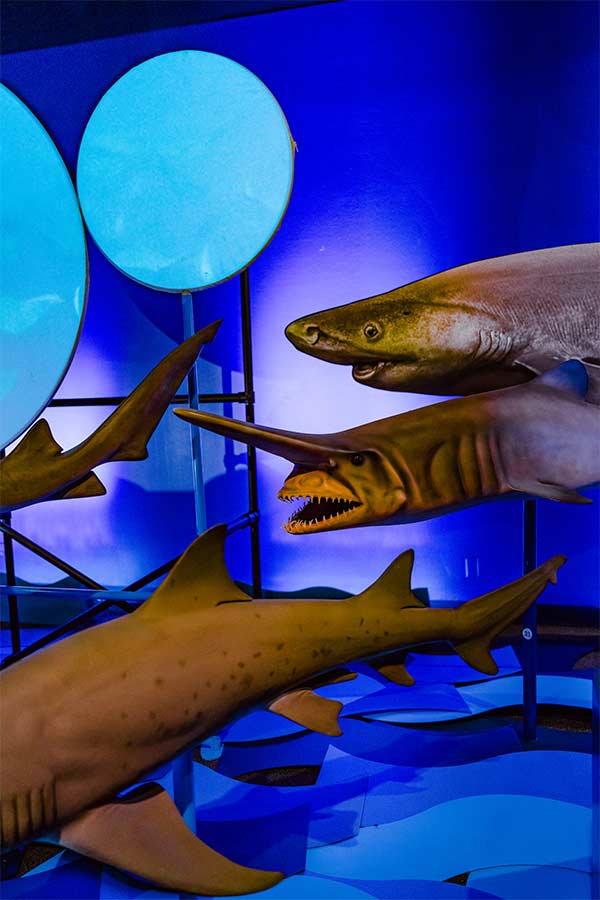Sharks
To be great is to be misunderstood
Come face to face with Sharks, the ocean's most magnificent and misunderstood species.
Sharks brings to life the incredible diversity of sharks with dozens of life-sized models, ranging from 33 feet to 5 inches long, and offers visitors a unique look at prehistoric and modern species, their habitats and hunting styles, and the conservation threats these spectacular animals face today. The evolutionary history of sharks is extraordinarily long, predating even dinosaurs. Today, more than 540 species of sharks and over 670 species of their close relatives — rays, skates, and chimaeras — inhabit nearly all the world’s marine environments, from coral reefs to the polar seas, and even freshwater rivers.
We hope people walk away from this exciting exhibition with a new appreciation for sharks and understand they are magnificent creatures that should be revered, not feared. John Sparks, curator in the Department of Ichthyology at the American Museum of Natural History and curator of Sharks
While the terrifying monster from the movie Jaws is what many might imagine when they think of sharks, today scientists are uncovering many surprising facts. The exhibition will showcase current research, replica fossils from the American Museum of Natural History's extensive collections, and a spectacular “parade” of sharks highlighting ancient and modern shark species.
Inside the Exhibition
Experience the diversity of species in the shark family, from prehistory to today. Learn about the evolutionary adaptations that make these creatures so complex and unique. Sharks is a bilingual exhibition, presented in both English and Spanish.
- See the prehistoric mega-predator megalodon, the “Tyrannosaurus rex of the seas,” which was so large it preyed on whales
- Hunt like a hammerhead in an activity that invites visitors to direct a shark using dynamic media
- Discover, through a touchless interactive game, how scientists use the spots on sharks like fingerprints to identify individual fish
Exhibition Sections
- Diversity of Sharks
- Ancient Sharks: Experience life-sized models and fossil casts, and learn about shark species that lived millions of years ago
- Predator/Prey: Illustrations, videos, models, and touchless interactive experiences explore the behaviors and adaptions of sharks. Their feeding styles are as diverse as their prey
- Biggest to Smallest Sharks: Discover the size of various species with models of sharks as big as the gigantic 33-foot whale shark to ones as small as the recently discovered 5.5-inch pocket shark
- Super Sensers: Sharks, rays, skates, and chimaeras have evolved some extraordinary sensing abilities. They can even detect things humans aren’t aware of — including electromagnetic fields and the direction of very low-frequency sounds
- Around the World: Discover the variety of shark habitats around the world and the specialized adaptations that help sharks succeed in their environments
- Sharks and Us
- Dangerous: Learn about the history of our fear of sharks, the relative danger of shark bites, and simple tips to avoid danger
- Vulnerable: Explore the various threats facing sharks as well as efforts to protect them
Educator Resources
Sharks is organized by the American Museum of Natural History, New York. The Museum gratefully acknowledges Warner Bros. Discovery for its generous support of Sharks. A selection of footage in Sharks has been provided by Discovery's Shark Week.
The Bullock Museum, a division of the Texas State Preservation Board, is funded by Museum members, donors, and patrons, the Texas State History Museum Foundation, and the State of Texas.
Lender
American Museum of Natural History
On View
At the museum: 11/11/2023 - 03/24/2024









